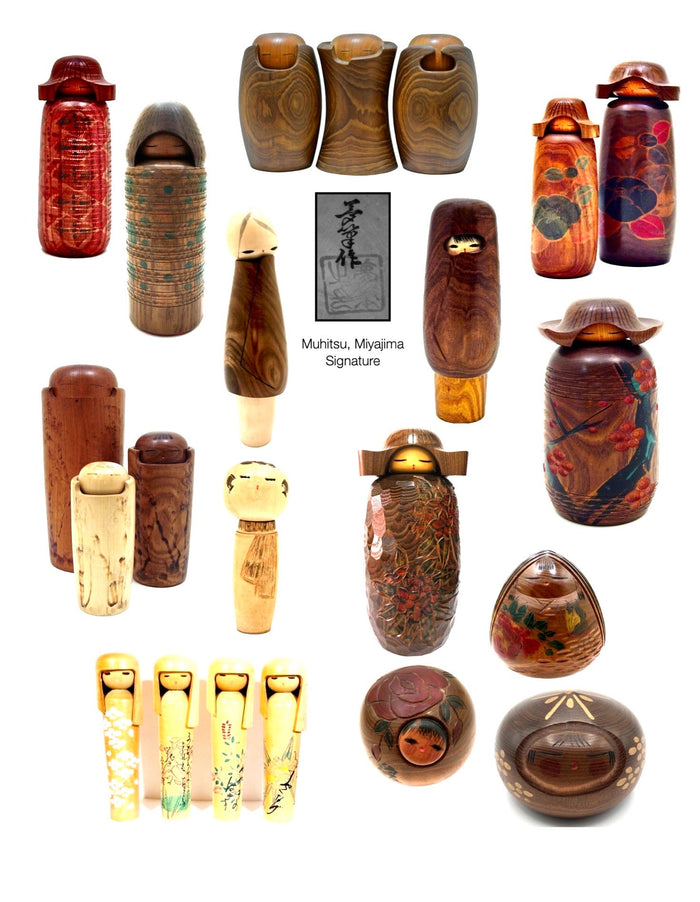

Vintage Sosaku Kokeshi entitled: “Tsubaki | Camellia” by Miyajima, Muhitsu (1929-)
Dimensions: 8-0”h
Of all Miyajima’s representations of this doll, it is the most beautifully painted and lathe-turned Kokeshi and is wearing a traditional Fuyu/winter ‘Kasa’, (hat), that is seen throughout Japan during this period. This kind of head covering is overly large, in a bowl or mushroom shape, and was originally made from woven rice straw. It does not come to a point like a rice farmer’s hat, nor ride high on the head like a Samurai’s traveling hat. The hat is beautifully rendered, and textured with incised line work in which the hat covers the upper half to two-thirds of the face. Thus, as it is designed to be, helps mask the identity of the person, allowing the individual to travel and enjoy traveling incognito. Her face is quite simple with horizontal eyes indicating a serene expression and a small red nose.
On only the front of the doll, the Kimono is intricately hand-painted and incorporates deeply carved red cherry blossoms on tree branches accented in black and highlighted in a bright blue-green pigment. The doll is made of Enju, (Pagoda wood), and lacquered with plant-derived wax used for the finishing. The piece is signed and named on the bottom by the artist.
The doll is published in Sosaku Kokeshi: Celebrating the Major Artists of the Creative Movement in 2022 on page 70. For more information on this artist go to the following link: https://mingeiarts.com/collections/artisan-woodworker-miyajima-muhitsu-1929.
Condition: Excellent meaning that the piece retains its original craft/workmanship shows a wonderfully-developed patina commensurate with age suggests a degree of wear that corresponds to its vintage and is void of damage, cracks, breakage, or repairs. This doll meets all the standards of the collectible Japanese Sosaku Kokeshi by Miyajima, Muhitsu.

Artisan
Woodworker: Miyajima, Muhitsu
1929-
Biographical History:
Muhitsu began making Kokeshi in 1942, under the apprenticeship of Kichitaro Kobayashi, a maker of traditional-style Kokeshi, and devoted himself exclusively to making Sosaku Kokeshi in 1949. Since 1965, Muhitsu has produced many award-winning dolls. Miyajima-san. His dolls have had a great influence on creative, (Sosaku) doll makers since then. A multiple award winner, Miyajima-san won the prestigious Prime Minister’s Award in 1973. No further information has been published on this artist.
Collector's note – descriptive qualities, standard characteristics & ornamentation styles:
Simple form and function is the theme to Miyajima-san’s creations. The wood is most critical in his interpretation of the seasons and often incorporates the snow coat called ‘Mino”, which adds depth and character to his pieces. The wearing of the traditional Fuyu Kasa, (hat), of the 1950s is seen on many of his works and was a kind of headcovering for Buddhists, which was overly large, in a bowl or mushroom shape, and was originally made from woven rice straw. Seasonal flowers, (Camellia), are often used along with Plum blossoms and tree branches, (see the two dolls at the top right named "Bairin or Plum Grove"). He typically incorporates sumi-e’ brush work into his representation of faces, and uneven carved grooving giving ornamentation and texture to the figure. Miyajima-san works in a variety of beautiful woods, but seems to prefer the heavy, dark colored Enju wood, (Pagoda tree), for it’s rich colors and interesting grain.
Explore & Learn More about Woodworker: Miyajima, Muhitsu